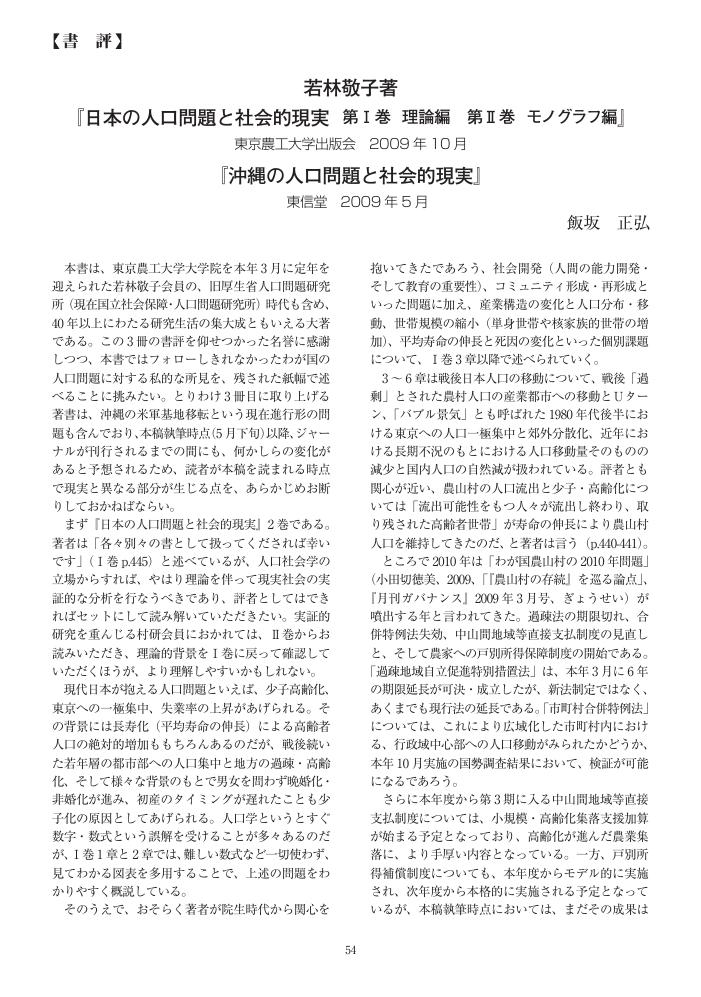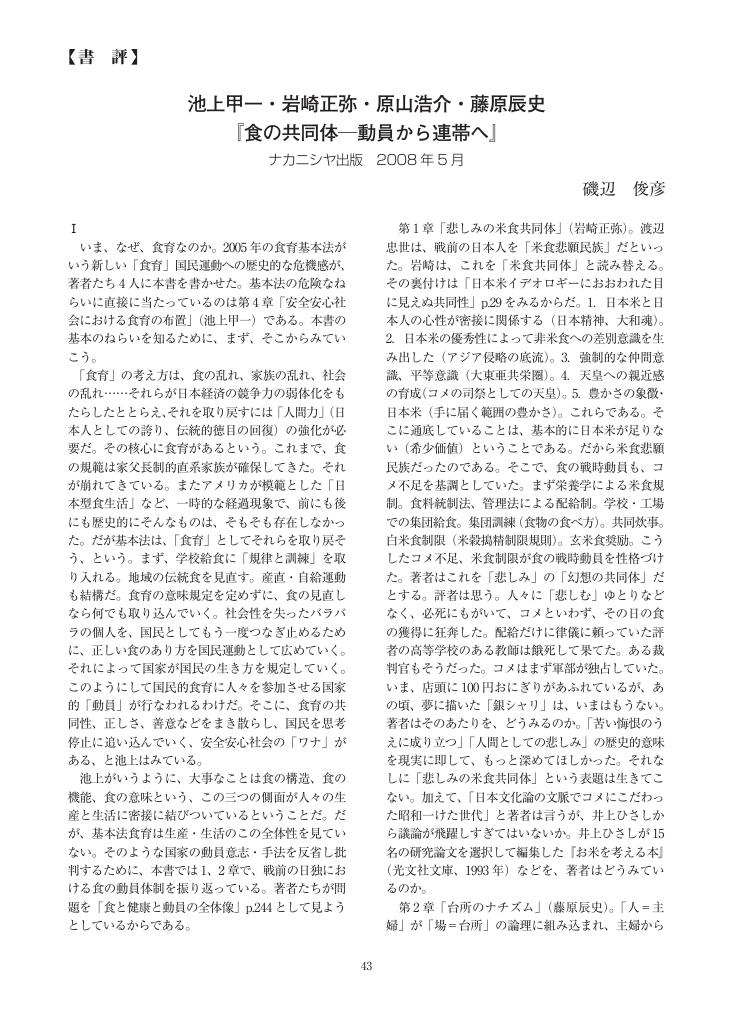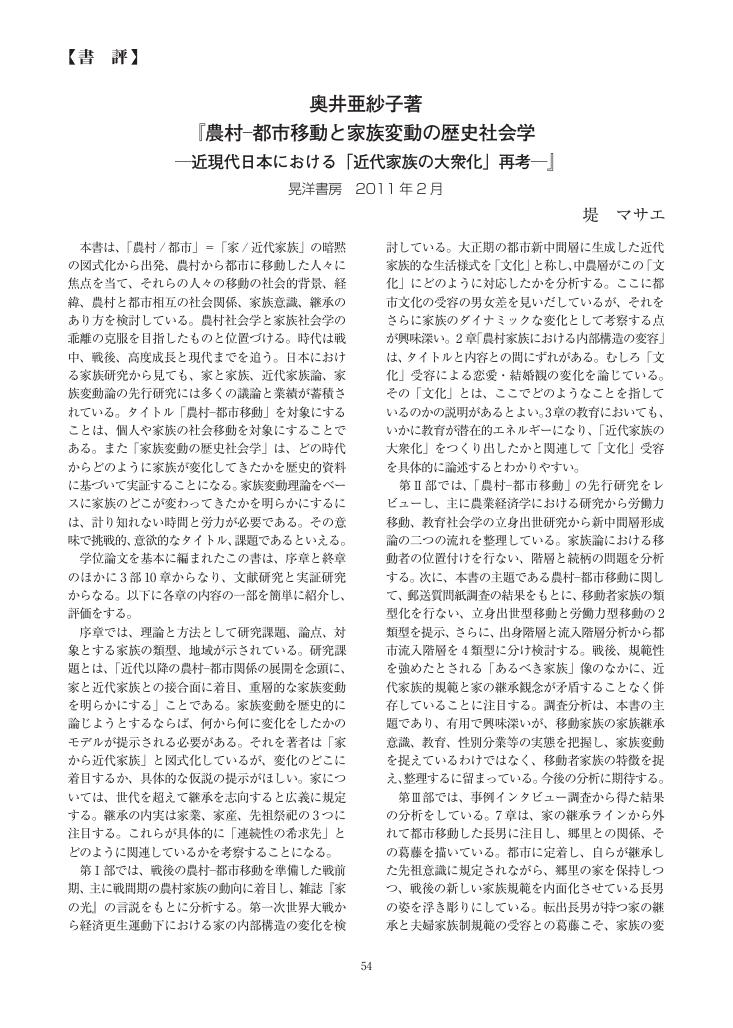1 0 0 0 OA 樺太植民地農政の中の近代天皇制
- 著者
- 中山 大将
- 出版者
- 日本村落研究学会
- 雑誌
- 村落社会研究ジャーナル (ISSN:18824560)
- 巻号頁・発行日
- vol.16, no.1, pp.1-12, 2009 (Released:2012-12-24)
- 参考文献数
- 58
- 被引用文献数
- 1 2
The imperial Constitution of Japan was established in 1889 and this meant that the modern Japanese imperial institution was also established. The imperial institution in this updated form remained influential throughout the Japanese Empire. In 1928, the Showa Emperor succeeded to the throne and a series of the ceremonies were held to recognize the transition called “Showa-no-Tairei.” Concurrently, in the imperial colony of “Karafuto,” the exemplary farmer campaign was launched by the colonial government of Karafuto. First, this study clarifies the facts on how the colonial agricultural administration of Karafuto utilized the modern imperial institution through the exemplary farmer campaign for its own particular aims. Second, this study discusses the logic for the linkage between Karafuto farmers and the Emperor within the campaign. The colonial government needed to use imperial ideology to make farmers of Karafuto adopt the ideal farming style it had planned, which differed from that of mainland Japan. The colonial government exposed the farmers to Imperial linkages via the ceremony of “Showa-no-Tairei,” in which the farmers were honored, and attempted to legitimize these linkages through the campaign. The logic behind these steps depended on three facts. First, the Showa Emperor toured Karafuto and granted an audience with some of the exemplary farmers when he was the prince. Second, he planted rice on a paddy field in the palace after the demise the Taisho Emperor. Third he made honorable recognition of some of the farmers and used and ate crops dedicated by the farmers at the ceremony of accession, “Showa-no-Tairei.” The colonial government hoped that the farmers and agriculture of Karafuto would become linked with the Emperor and the Empire itself by these facts, and that this linkage would familiarize farmers with an ideology of hard work in order to attain the farming style planned by the colonial government.
1 0 0 0 OA 割地制度とコモンズ
- 著者
- 佐藤 康行
- 出版者
- 日本村落研究学会
- 雑誌
- 村落社会研究ジャーナル (ISSN:18824560)
- 巻号頁・発行日
- vol.17, no.1, pp.23-35, 2010 (Released:2013-01-26)
- 参考文献数
- 65
This article considers contemporary conditions of warichi in both irrigation and forests in Nishikanbara-gun, Niigata prefecture, from the perspective of the commons. The warichi , allegedly established in early modern Japan, is a redistribution system of arable land and forest to share risks associated with natural disasters and to pay land taxes proportionally among landholders in each village. Therefore, the warichi is a corporate form of landholdings. This article presents research from the contemporary conditions of warichi in two cases. I found that the warichi formally remains in the mountain forest, while it has been eliminated in the cultivated land holdings. Considering the landholders’ managing irrigation systems today, warichi could be called a commons. The mountain forest can be said to continue to be commons in that ordinary people can access the areas and enjoy climbing the mountain. Furthermore, this research finds that the mountain forest would be better managed by a cooperative network between mountain landholders, local public administration, and volunteer groups.
1 0 0 0 OA 沖縄の泉水施設の変遷とムラの戦略
- 著者
- 鳥越 皓之
- 出版者
- 日本村落研究学会
- 雑誌
- 村落社会研究ジャーナル (ISSN:18824560)
- 巻号頁・発行日
- vol.17, no.1, pp.1-10, 2010 (Released:2013-01-26)
- 参考文献数
- 15
- 被引用文献数
- 2
This paper aims to explore the reasons behind the appearance of unattractive and formalized parks in rural Japanese communities, especially in those wherein community members enthusiastically participate in the planning of the recreation and leisure areas. Traditionally, rural communities in Japan have been characterized by clear boundaries and strong institutions such as Jichikai , having maintained a Gemeinschaft society. In this paper, we analyze the village of Yoza in the southern area of Okinawa’s main island. In 1944, 41% of the villagers were killed during the invasion of the US Army. However, even after losing many community members, these villages have restructured their organizations and have carefully restored and maintained their common buildings and fields during the more than 50 years that have passed since World War II. Usually, parks that have no historical or regional identity and have impersonal atmospheres are planned by the administrative offices of local governments. However, in a few cases, unattractive parks arise even when community members are actively involved in their planning. The Yoza community is such a case. An analysis of the community’s involvement in the planning of park areas revealed two direct reasons, namely, the subsidy system of the central government and the occupation by the Allied Forces, and one fundamental reason, that is, the values of its inhabitants.
1 0 0 0 OA 先人の足跡を今に活かす
- 出版者
- 日本村落研究学会
- 雑誌
- 村落社会研究ジャーナル (ISSN:18824560)
- 巻号頁・発行日
- vol.20, no.2, pp.10-38, 2014-04-25 (Released:2015-07-10)
1 0 0 0 OA ベトナムの「自治村落」と農民組織
- 著者
- 岡江 恭史
- 出版者
- 日本村落研究学会
- 雑誌
- 村落社会研究ジャーナル (ISSN:18824560)
- 巻号頁・発行日
- vol.21, no.2, pp.10-22, 2015-04-25 (Released:2016-05-13)
- 参考文献数
- 40
Hitoshi Saito argued that Asian countries except Japan could not develop agricultural cooperatives because their rural societies do not have the inheritance of autonomous community. But, the facts of Vietnam and China are contrary to Saito's theory. Vietnam has not yet developed agricultural cooperatives in spite of the inheritance of autonomous community. On the other hand, China has developed agricultural cooperatives without the inheritance of autonomous community. The purpose of this paper is to examine these facts through comparative research of Japan, China and Vietnam on history and social structure. Japanese autonomous villages have established their integration units and developed cooperative relationship with outside. Chinese villages do not have autonomous function. But, market economy has permeated Chinese rural society over many years, and many Chinese people have personal connections outside their villages. Many Vietnamese people have not personal connections outside their villages. The author concludes that the requirements for development of agricultural cooperatives are strengthening of market economy and the networks beyond each village.
- 著者
- 飯坂 正弘
- 出版者
- 日本村落研究学会
- 雑誌
- 村落社会研究ジャーナル (ISSN:18824560)
- 巻号頁・発行日
- vol.17, no.1, pp.54-57, 2010 (Released:2013-01-26)
1 0 0 0 OA 池上甲一・岩崎正弥・原山浩介・藤原辰史『食の共同体―動員から連帯へ』
- 著者
- 磯辺 俊彦
- 出版者
- 日本村落研究学会
- 雑誌
- 村落社会研究ジャーナル (ISSN:18824560)
- 巻号頁・発行日
- vol.17, no.2, pp.43-44, 2011 (Released:2013-04-20)
- 被引用文献数
- 1
- 著者
- 堤 マサエ
- 出版者
- 日本村落研究学会
- 雑誌
- 村落社会研究ジャーナル (ISSN:18824560)
- 巻号頁・発行日
- vol.19, no.1, pp.54-55, 2012-10-25 (Released:2014-11-04)
- 著者
- 飯塚 里恵子
- 出版者
- 日本村落研究学会
- 雑誌
- 村落社会研究ジャーナル (ISSN:18824560)
- 巻号頁・発行日
- vol.14, no.2, pp.56-57, 2008 (Released:2012-11-19)
1 0 0 0 OA 埼玉県比企郡小川町における有機農業の展開過程
- 著者
- 小口 広太
- 出版者
- 日本村落研究学会
- 雑誌
- 村落社会研究ジャーナル (ISSN:18824560)
- 巻号頁・発行日
- vol.18, no.2, pp.36-43, 2012 (Released:2014-05-10)
- 参考文献数
- 12
- 被引用文献数
- 3
The purpose of this study is to analyze the regional relationship and the development process of organic agriculture in Ogawa-Town, one of the pioneering areas of organic agriculture in Japan. Organic agriculture in Ogawa-Town was started in the beginning of 1970s by a local farmer named ‘K’. Being engaged in his farming, ‘K’ made direct contact with several consumers and local food enterprises in order to supply his products, and accepted people willing to begin organic farming as trainees on his farm, some of them later started organic farming as independent farmers. Since the late 1980s the number of such newcomers in organic agriculture has gradually increased also in Ogawa-Town, while local farmers except for ‘K’ still continued conventional farming. It was in 2001 that one local farmer named ‘A’ changed his way of farming from ‘conventional’ to ‘organic’, partly because of his aging and increase of abandoned farm land. Conclusively, the development process of organic agriculture in Ogawa-Town is quite characteristic in the sense that organic farming gradually extended in the town, caused by social change surrounding agriculture rather than by social movement of farmers’group.
1 0 0 0 韓国における帰農現象の特徴:──農村移住研究への新たな視座──
- 著者
- 大前 悠
- 出版者
- JAPANESE ASSOCIATION FOR RURAL STUDIES
- 雑誌
- 村落社会研究ジャーナル (ISSN:18824560)
- 巻号頁・発行日
- vol.19, no.2, pp.37-48, 2013
- 被引用文献数
- 1
This paper aims to clarify the characteristics of urban to rural migration in South Korea and discuss the perspectives on studies of rural migration.<br> In Korea, after economic crisis in 1997, many urban residents, especially young workers moved rural areas.This phenomenon was called"kwinong", meaning return to nature.<br> The kwinong movement has experienced another increase since 2005, mainly occupied by people over the age of 40, including retirees and those taking early retirement.<br> Previous studies that discussed rural migration in developed countries focused on the rurality of inmigrants because their behavior in rural life is supposed to depend on their rurality. So rural migration has been explained under the context of Post-Productivism, that consumptive gaze at rural space prompts urban residents to move to rural area.<br> Analyzing 33 individual cases, people over the age of 50, rural migration is motivated by a search for well-being life that resembles that depicted in the literature.<br> But for those in their 40's, their motivations deeply reflect an excessive competitive society that rapidly formed after the economic crisis in 1997. The labor system force many employees to retire from their companies while in their 40's and continue to work overtime, while their children are suffered from more competitive educational environment.<br> The urban to rural migration in recent Korea may be best described as resulting from a direct urban push factor than a rural pull factor.<br> Simply analyzing this case from a Post-Productivist perspect would omit the impact that changes in social conditions under rapid Neo-liberal policy implementation have upon rural migration.<br> To better understand rural migration, it is important to properly examine the socio-economic conditions generating rural migration.




